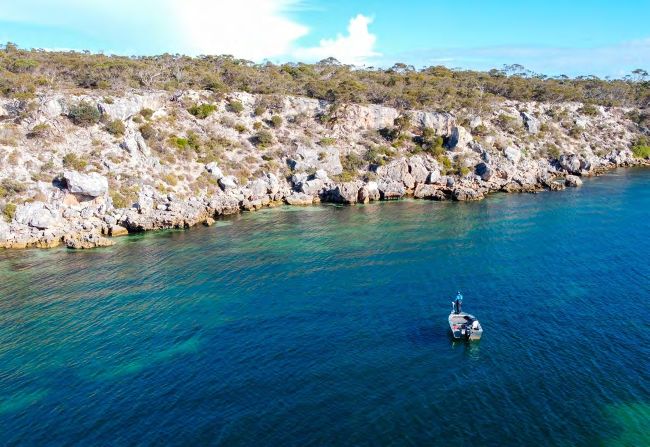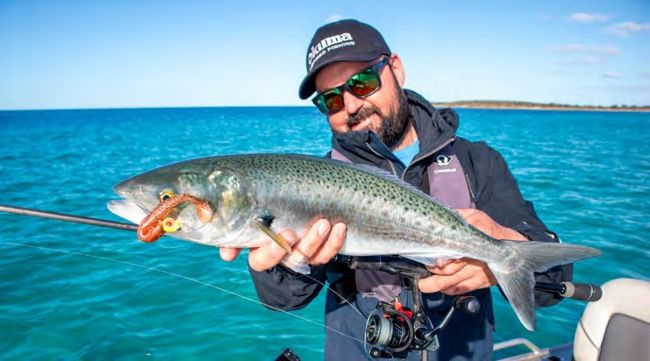AUTUMN FLATHEAD TACTICS
Lubin Pfeiffer passes on some valuable hints and tips to improve your Autumn flathead catch.
Autumn in SA is one of the best times of year to chase flathead on lures. We are lucky in this state to have a wide variety of locations to target these fish. Catching flathead on lures was something I always wanted to be successful at, but I could never really consistently crack the code. Over the last few years I put more time into it and now can catch them with some sort of regularity. I think the biggest thing to remember is that flathead are actually easy to catch – you just need to find the areas where they like to hang out. You also need to fish with a lure that’s easy to use and to have it in the water long enough to get a bite.
WHERE TO FISH
Flathead can be targeted successfully from the shore or in a boat. The boat will give you access to a lot more areas, but it is not completely necessary to have an amazing session in SA. One of the biggest keys to success in flathead fishing is finding the right area to fish in the first place. From my experience, flathead love shallow, sandy bays with a good mix of rocks and weed pockets – areas where they can ambush a prey item and then return to a patch of cover. There’s plenty of this type of terrain in this state, with the best of it being over on the West Coast, in my opinion.
One big thing I have found when looking for flathead spots is that the fish like water that has some influence from the open ocean.
If you can find a beach that’s not being smashed by swell and has a good mix of cover, the flatties will be in there. This is where we are so lucky to have access to technology, such as swell reports and wind predictions, because you can pinpoint the most likely best area before planning a mission. I like to use this and also Google Earth to search out new areas for flathead fishing.

Prospecting the edges in Coffin Bay
I think the one downfall of flathead as a species is that they are so aggressive, and if you find a good area, it is easy to overfish it if you choose to kill the fish for a feed. That’s where finding less-fished locations will definitely lead to better fishing. Don’t get me wrong. You can catch a flathead on a lure in populated centres, it is just the best fishing will come from those areas a bit off of the beaten track.
GEARING UP
I like a 2.1m, 2-4kg spinning rod matched to a 2500 size spinning reel loaded with a 3kg brightly-coloured braid. The leader choice is an important one because flathead do have pretty sharp teeth, especially the best ones, so I like to use a 6.8kg fluorocarbon leader. To attach this I like to use an FG knot because it is a very good connector for tying leaders that are quite a bit thicker than the main line you are using. The FG is a super slim knot and will travel through the guides seamlessly on a small spinning rod. It’s important that ever y thing is smooth and easy to use because you will be doing lots of casting looking for fish.
A couple of other items that make life easy while flathead fishing from the shore are a sling pack and a pair of sturdy wading boots. I like to use the TT sling pack, which has plenty of storage, but also a built-in rod holder so you can change lures without ever putting your rod in the sand. Walking the sand is not an issue. It is the bits in between that will cause your feet drama. The West Coast has plenty of jagged rocks that will make short work of skin during a slight trip. This is why good footwear will make for a far more enjoyable experience.
While fishing from the boat, the most important item in my opinion is an electric motor so you can methodically work an area of coastline. Drifting is an option if you don’t have an electric motor, but nothing compares to the control and efficiency of an electric for lure fishing.
FAVOURITE LURES
Flathead will eat a wide variety of baits, but I’ve now settled on a couple of confidence baits that work regularly for me. These are a 4-inch Zman Diezel Minnowz and also a 4-inch Zman Mulletron. I’ll rig both of these on either a 1/4oz or 1/6oz TT Snakelockz weedless jig head. These weedless baits can be worked through all the likely terrain without snagging up or getting covered in weed constantly. Colour doesn’t seem to matter a lot, but I do like matching a brightly-coloured jig head to a natural coloured plastic. This way you have the attraction of a hot spot for the fish to see, but then a real-looking bait for the fish to eat. There are heaps of lures on the market to catch flathead, but a simple packet of plastics and jig heads is a very cost-effective option if you are just starting out.

Salmon are an entertaining by-catch
The way I like to retrieve the lure is to keep it as close to the sand as I can between lifts. Usually, my cast is not super long because I want to actively target likely holding spots in between the weed and rocks. Once the lure has rested on the bottom, I’ll do a lift of the rod to get the bait moving before letting it rest again and winding up the slack. Flathead will follow a lure when it’s moving, and the pause gives them a chance to eat it. The bite is very distinctive, and you will absolutely know when a good-sized flatty has eaten your lure. Quite often the fish will hit the lure but miss it before coming back for another crack. So, if you do get a bite, be sure to leave your lure in the zone or get it back in there quickly before the fish loses interest. I like to work through areas pretty quickly, because if there is a flathead there, usually it will be on to the lure pretty quickly!
Autumn is such a great time to chase flathead in our state because the weather usually settles down a bit, which means clearer water more consistently. There is so much water to explore and one of the great things about chasing flathead is the amazing locations they take you to!